Kiteboarding Adventures in Mauritius: A Comprehensive Guide
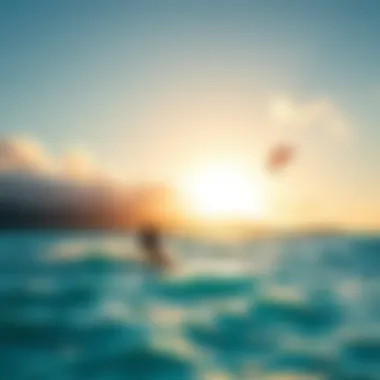
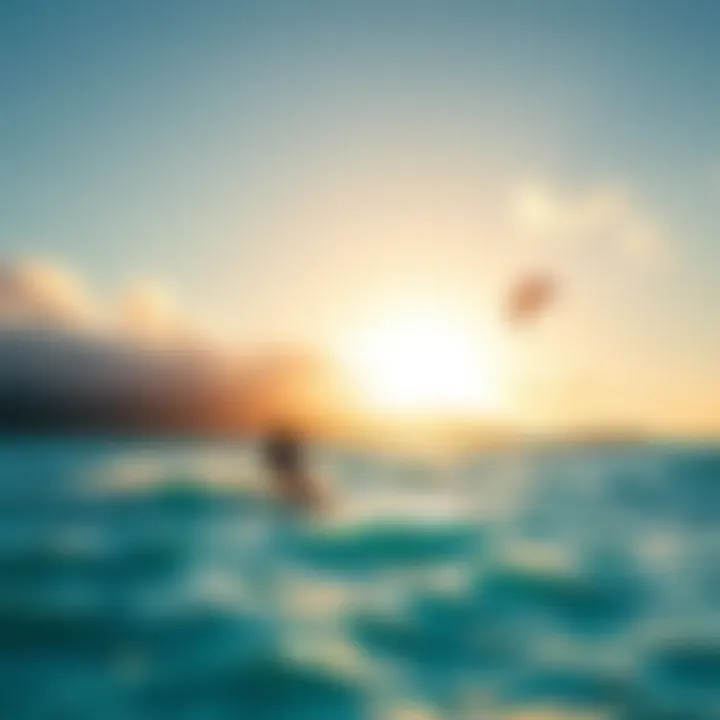
Intro
Kiteboarding in Mauritius is not just another water sport but a true adventure, appealing widely to adrenaline junkies and those who seek serenity on the waves alike. With its vast turquoise lagoons, consistent winds, and sun-soaked beaches, the island has crafted a snug niche in the world of kiteboarding, gaining traction among both fledgling enthusiasts and seasoned pros.
What makes this destination stand out? It’s a kaleidoscope of geographical marvels, cultural richness, and community spirit that envelops all who arrive. No matter your skill level, Mauritius offers a playground where one can harness the winds like a pro or simply enjoy the sheer joy of riding the waves.
This guide aims to etch a clear pathway, illuminating the essentials one needs to embrace and thrive in kiteboarding here. From picking the right gear to mastering essential safety practices, we'll sift through the intricate details that enhance your kiteboarding escapades and ensure you not only ride the waves but savor every moment.
Let’s delve deeper into the Gear and Equipment necessary for a fulfilling kiteboarding experience.
Intro to Kiteboarding
Kiteboarding is not just a sport; it’s a captivating blend of adventure, skill, and the raw power of nature. In this section, we’ll discuss the essence of kiteboarding and how it sets the stage for a deeper exploration of this thrilling activity in the stunning surroundings of Mauritius.
Understanding Kiteboarding
At its core, kiteboarding combines elements of surfing, wakeboarding, and paragliding. Riders harness the wind’s energy using a specially designed kite, propelling themselves across the water while standing on a board. The surge of adrenaline you feel as you glide over waves, perform aerial tricks, or engage in simple cruising is unparalleled. The beauty of kiteboarding lies in its accessibility; from beginners who merely want to ride the gentle wind to pro athletes executing breathtaking stunts, this sport has something to offer everyone.
Kiteboarding’s blend of fun and fitness is another appealing characteristic. It challenges your balance, strengthens core muscles, and sharpens focus—all while enjoying the great outdoors. There’s a sense of freedom that comes with it; you’re not just riding the waves, you’re dancing with the wind.
The Kiteboarding Evolution
Kiteboarding has a rich history that continues to evolve. What began as a niche sport in the 1970s has transformed into a global phenomenon, heavily influenced by advancements in technology and equipment design. Initially, the kites were heavy and cumbersome, making it difficult for riders to maneuver. Fast forward to today, and the kites are forged with super lightweight materials, offering immense control and stability.
Consider the progression of the boards. Old designs limited movement and responsiveness, but now, there’s a variety of shapes and sizes adapted for specific conditions and skill levels. Whether it's a twintip or a directional board, riders can now choose the best fit for their style.
The growth of kiteboarding has also given rise to a vibrant community. From local clubs to global competitions like the Kiteboarding World Cup, the sport fosters camaraderie and a shared passion among enthusiasts. These engaging environments not only push riders to improve but also facilitate the exchange of tips and experiences.
Kiteboarding isn’t merely a pastime; it’s a gateway to thrill and connection with fellow adventure lovers, making each session unforgettable.
As we dive deeper into this article, we'll explore Mauritius as the ultimate kiteboarding destination and its unique offerings. Here, optimal conditions blend with picturesque landscapes, creating an unforgettable experience for kiteboarders of all skill levels.
Mauritius: A Kiteboarding Paradise
Mauritius is not just another tropical getaway; it is a prime destination for kiteboarding. This island offers a smorgasbord of experiences that attract both novices and seasoned riders alike. The blend of stunning seascapes, steady winds, and favorable conditions sets the stage for an unforgettable time on the water. Kiteboarders flock here not only for the thrill of the sport but also for the camaraderie that thrives in local communities. The welcoming vibe and the enchanting surroundings contribute to an overall kiteboarding culture that is hard to replicate elsewhere.
Geographical Advantages
The geographic layout of Mauritius is nothing short of spectacular when it comes to kiteboarding. The island's location in the Indian Ocean, combined with its coral reefs and unique lagoons, provides safe and predictable spots for kiteboarding. Areas like Le Morne are particularly favored due to the flat waters created by the reefs, which also help mitigate any strong waves, making it a perfect playground for both learning and executing advanced maneuvers.
- Diverse Locations: From the sheltered lagoons to the more challenging wind-swept open seas, each kiteboarding spot offers a different experience. This variety allows enthusiasts to switch up their routines without having to venture far.
- Natural Barriers: The protective reefs serve as natural windbreaks. This means that even on windier days, kiteboarders can enjoy a smoother ride, promoting a safer environment for all levels of skills.
- Breathtaking Scenery: The stunning backdrop of Mauritius enhances the experience. Picture crystal-clear waters against lush greenery—it’s a sight that very few other destinations can match.
Overall, the topography and natural features of Mauritius issue an irresistible invitation for kiteboarders and windsurfers from around the globe. The ease with which one can find a flat-water spot or a larger wave means everyone—from first-timers to experienced thrill-seekers—can find their niche.
Climate and Wind Patterns
When it comes to kiteboarding, the climate plays a pivotal role. Mauritius benefits from a warm tropical climate with trade winds that provide consistent conditions ideal for kiteboarding.
- Wind Seasonality: The primary kiteboarding season runs from May to September, when the trade winds blow steadily. During these months, the wind can often reach speeds of 15 to 30 knots, ensuring there’s enough push for even the most adventurous stunts.
- Stable Temperatures: With temperatures averaging between 25°C and 30°C, riders can enjoy long sessions without having to bundle up. Even during the rainy season, the warm rains are often brief, allowing for playtime in the water.
- Predictable Patterns: Local weather patterns can be fairly predictable, which is a comforting thought for those scheduling their kiteboarding itineraries. Morning winds usually pick up steadily and taper off in the late afternoon, which allows enthusiasts to plan their sessions effectively.
"Kiteboarding in Mauritius is often described as riding a roller coaster over the Caribbean Sea—thrilling yet manageable for everyone."
In summary, the climate and wind patterns of Mauritius create a seasonal rhythm certain to entice kiteboarders all year round. Whether you’re looking for calm waters for practice or gusty seas for challenging ridnig, the weather here spokes one of adventure and exhilaration.
Top Kiteboarding Spots in Mauritius
Mauritius, with its breathtaking landscapes and consistent winds, offers a plethora of kiteboarding sites that cater to all skill levels. Knowing the top kiteboarding spots on the island is essential for making the most of your adventure. Each location has its quirks and nuances.
Le Morne: The Crown Jewel
Le Morne stands out as a destination that’s often praised by kiteboarders from around the globe. The area is not just a pretty face; it offers unique characteristics intertwined with its stunning scenery.
Spot Features
One of the key aspects of Le Morne is its diverse environment that includes flat waters and appealing waves. For the novice, the lagoon provides a safe space to learn without the hassle of big waves crashing over you. On the other hand, experienced riders will relish the more challenging conditions outside the lagoon. The beauty of Le Morne lies in its adaptability to various skill levels, making it a popular choice among all kiteboarders.
A remarkable feature of Le Morne is the iconic backdrop of the Le Morne Brabant mountain, which not only serves as a natural guidepost but also adds to the aesthetic appeal of the spot—perfect for capturing memories.
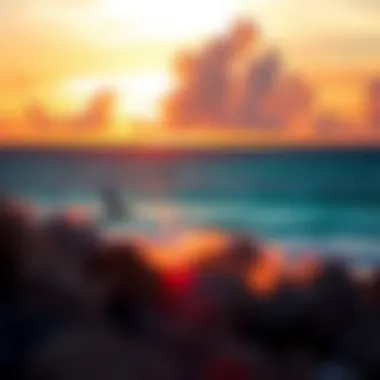
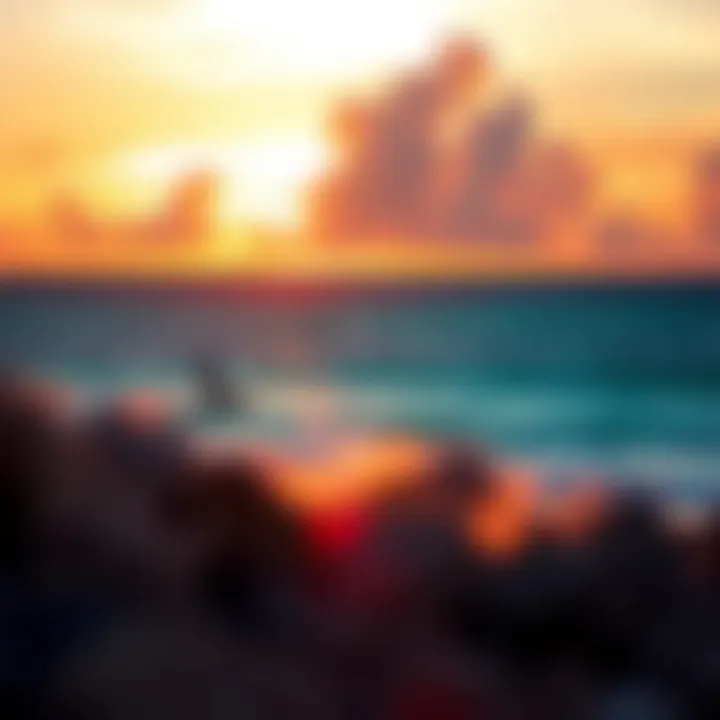
Best Times to Visit
The best times to visit Le Morne vary slightly, depending on what you’re looking for. Generally, from May to October, the winds blow consistently, offering optimal conditions. This timeframe tends to draw the crowds, so if you're keen on avoiding the bustle while still enjoying great wind conditions, consider visiting in the shoulder months like April or November.
Unique features about this timing include the temperature, which remains quite pleasant, allowing kiteboarders to enjoy extended hours on the water without feeling fatigued. Nonetheless, it's wise to keep an eye on local wind forecasts to pick the perfect day.
Local Amenities
Accessibility to local amenities is another advantage of Le Morne. Within a short distance, you can find several eateries and rental shops catering specifically to kiteboarders. From where to grab a bite to where to get your gear repaired, it’s all within reach.
Further, the variety of accommodations ranges from luxury resorts to budget-friendly guesthouses. This variety allows kiteboarders to select their style and comfort level, which can significantly enhance the overall experience.
Trou Aux Biches: The Hidden Gem
While not as famous as Le Morne, Trou Aux Biches has carved out its niche as a hidden gem for kiteboarders. More than just a tranquil beach setting, it has become a favorite spot for those seeking a mix of calm waters and exhilarating rides.
Unique Characteristics
Trou Aux Biches boasts a softer ambience, ideal for beginners mastering their techniques. The beach is lined with picturesque palms that add a tropical vibe, creating a relaxed environment. Here, riders can glide over serene waters while enjoying the peaceful surroundings.
Its beach caters to those who might want a change, providing an alternative vibe to spots that are frequently bustling with activity. Nonetheless, don’t mistake this peace for less quality; the spot holds its own when the conditions align, often surprising experienced riders.
Ideal Conditions
For kiteboarding enthusiasts, the ideal conditions arise mainly between June and August, characterized by steady winds and favorable waves. However, even during the offseason, there’s often enough wind to keep kiteboarders content. The beauty of Trou Aux Biches is that it still feels exclusive, even when the weather is at its prime.
These conditions shine a light on the cove’s potential while allowing ample room for both beginners and professionals to practice their skills without overcrowding.
Accommodation Options
Accommodation options at Trou Aux Biches are varied, with many places offering easy access to the beach. From luxurious beachfront hotels to more budget-friendly choices, there's something for everyone. Proximity to the water means you spend less time traveling and more time riding waves.
However, it's essential to book ahead during peak season to avoid being left high and dry, especially since the area’s charm draws many visitors.
"Exploring different spots is part of the thrill of kiteboarding; each location has its unique rhythm and charm."
By understanding these kiteboarding hotspots in Mauritius—Le Morne and Trou Aux Biches—you arm yourself with knowledge crucial for crafting unforgettable experiences. Each spot offers its own blend of wind patterns, landscapes, and community feel, shaping your kiteboarding journey on this magnificent island.
The diversity of the locations ensures that every type of rider finds a spot that resonates with their own style and needs.
Essential Gear for Kiteboarding
When diving into the world of kiteboarding, having the right gear is paramount. This sport relies heavily on not just skill but also the equipment that a rider uses. The right set of gear can mean the difference between an exhilarating ride and an arduous struggle against the elements. In Mauritius, where conditions can shift quickly, having high-quality, well-suited equipment enhances both safety and enjoyment. Here, we’ll navigate through the essentials of kiteboarding gear to ensure every rider can make the most of their experience.
Choosing the Right Kite
Selecting the perfect kite is like finding your soulmate in the vast sea. Each kite is a unique blend of size, shape, and technology designed for specific wind conditions and riding styles. Generally, kites are categorized into two main types: C kites and bow kites. C kites are known for their performance, excelling in tricks and speed, while bow kites provide excellent stability and are more forgiving for beginners.
When choosing, consider the following:
- Size: A larger kite captures more wind but can be harder to control. A smaller kite offers better maneuverability. Based on your weight and local wind conditions, select accordingly.
- Material: Most kites are made of durable, lightweight fabrics like ripstop nylon, which resists tears and punctures.
- Wind Range: Review the wind range of the kite to ensure it matches the prevalent conditions found in Mauritius. Some kites perform better in lighter winds while others thrive when the winds are strong.
The right kite will enhance your confidence on the water and can often be the first step towards mastering more complex moves.
Boards: Material and Design
The board you choose can dramatically affect your performance on the water. Kiteboards generally come in two main styles: directional boards, typically used for surfing-style riding, and twin-tip boards, best for jumping and versatile maneuvers.
Material Considerations
- Wood: Provides a classic feel with a decent flex, offering comfort and responsiveness.
- Carbon Fiber: Lightweight and high-performance, these boards allow for swift maneuvers but can be pricier.
- Plastic: Often used in beginner boards for durability and cost-effectiveness.
Design Aspects
- Size: Board size not only impacts speed but also stability. Generally, a longer board is better for beginners as it helps with planing in light winds.
- Shape: The rocker line, or the curve of the board, can influence how well it handles chop. A more pronounced rocker can make it easier to ride in rough conditions found sometimes around Mauritius.
Choosing the right board is an exercise in balancing personal style and practical considerations. It can be beneficial to test out different boards to feel which suits your riding aesthetic best.
Harness Types and Their Benefits
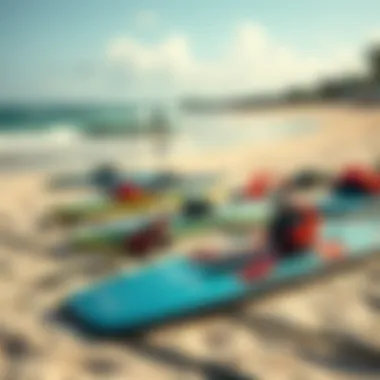
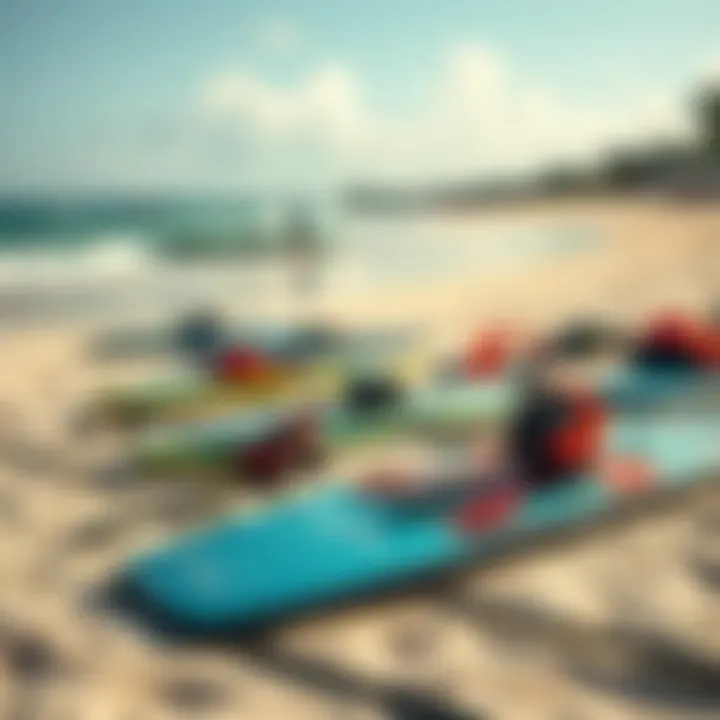
A kiteboarding harness is often overlooked, yet it's the piece of gear that connects the rider to the kite itself. A good harness can help distribute the force exerted by the lines evenly across your body. There are two primary styles:
- Waist Harness: Offers more freedom for movements, well-suited for freestyle riding and jumping.
- Seat Harness: Provides better support for beginners or those who prefer a more secure fit. This harness type helps in reducing the strain on the lower back.
When selecting a harness, consider the following:
- Comfort: Look for a harness that features padding and is adjustable. Remember, if it’s uncomfortable, you might not enjoy long sessions on the water.
- Support: A harness should provide enough support to keep you in control when you're powered up by a powerful kite.
- Safety Features: Ensure it has a quick-release mechanism. In situations where you need to disconnect quickly, being able to do so can be vital.
Having the right harness can make all the difference, preventing discomfort and enabling riders to fully engage with their kiteboarding adventure.
"The harmony between the kite, the board, and the harness creates an experience where nature and rider converse seamlessly."
Equipping yourself with the right kiteboarding gear is the foundation of a fulfilling kiteboarding journey in Mauritius. Not only does it enhance performance, but it also elevates the entire experience, allowing riders to focus on mastering the beautiful skill of riding the waves.
Safety Considerations
Kiteboarding presents not just exhilarating moments but also potential hazards, making safety considerations a top priority for anyone engaging in this sport. Whether you are a novice or an experienced rider, being aware of specific risk factors and having the right gear can make the difference between a fantastic adventure and a dangerous mishap. This section explores vital aspects of safety in kiteboarding, ensuring you have a solid grasp before hitting the waves.
Understanding Risk Factors
When you're out on the water, you might feel invincible, but understanding the risks involved in kiteboarding is crucial. Factors like weather conditions, equipment failure, and environmental obstacles can contribute to potential dangers. For instance, sudden gusts of wind can overpower even the most skilled kiteboarder, leading to loss of control. It's vital to stay updated on weather forecasts and be prepared to gracefully adapt to changing conditions.
Moreover, the environment itself can pose risks. Areas with rocky shores or hidden reefs can result in serious injuries if you're not cautious. Therefore, always scout your chosen spot and be mindful of the surroundings.
Some key risk factors include:
- Wind Conditions: Always check for gusty winds and their direction.
- Crowded Waters: Stay alert, as you may be sharing the space with other kiteboarders, swimmers, or boats.
- Local Wildlife: In certain areas, marine life can pose unexpected problems.
By recognizing and addressing these risks, you stand a better chance of enjoying kiteboarding to the fullest.
Safety Equipment Checklist
Preparation is half the battle, especially in a sport as dynamic as kiteboarding. Having the correct safety equipment can be a real lifesaver. Here’s a checklist of essential gear you should always have on hand:
- Helmet: Protects your head from unexpected falls.
- Impact Vest: Offers buoyancy and cushioning during accidents.
- Life Jacket: A basic but crucial item for water safety.
- Safety Leash: Ensures that your kite remains attached to you in case it falls.
- Wind Suppressor: Reduces the chances of sudden power pulls from strong gusts.
- First Aid Kit: Always wise to have just in case.
"Safety is not just a priority; it’s an essential part of enjoying your kiteboarding experience."
Moreover, remember to regularly check your gear for signs of wear and tear. Using worn-out equipment can be a recipe for disaster. For those new to the sport, consider joining a local kiteboarding community to share knowledge and insights about gear maintenance and safety practices.
By incorporating these safety considerations into your kiteboarding routine, you’ll not only ensure your wellbeing but also enrich your overall experience on the water. As the saying goes, it is better to be safe than sorry!
Techniques for Improvement
Enhancing your kiteboarding skills is vital not only for safety, but also to truly savor what the sport has to offer. Mastery in this field opens new avenues of experience, allowing one to enjoy the thrill of varying wind conditions and complex maneuvers. Improvement in kiteboarding involves both the technical skills required to control the kite, as well as the physical conditioning that supports sustained performance.
The continual evolution of kiteboarding techniques has been shaped by the needs of riders seeking to push their limits. With the right guidance and dedication, the growth in your abilities can be profoundly rewarding.
Essential Skills for Beginners
When you first step onto the board, it can feel daunting. However, mastering a few fundamental skills is the key to gaining confidence on the water.
- Kite Control: Understanding how to handle the kite is perhaps the most crucial skill. Practice controlling the kite on land before heading into the water. Learning to steer and finesse the kite will give you a sense of connection and control, preparing you for water starts.
- Body Positioning: Maintaining the correct posture while on the board is essential. Bend your knees slightly, lean back, and keep your weight centered over the board. This positioning will help you avoid wipeouts.
- Water Starts: One of the major milestones for newcomers is the water start. A basic method involves positioning the board in front of you while the kite is pulled overhead. As the kite generates power, slide your feet onto the board and ride away. It takes practice, but repetition will yield results.
- Edge Control: Learning to edge—using your toes and heels to cut into the water—helps control speed and direction. The body’s alignment with the kite is necessary for effective edging. Consider practicing this technique in varying wind conditions.
- Fall Recovery: Learning how to fall properly is just as important as knowing how to ride. Not all wipeouts are the same. Knowing how to recover without risking injury is vital; which leads to less anxiety the next time you hit the water.
As you practice these skills, remember that patience and persistence go hand in hand with progress.
Advanced Maneuvers for Experienced Riders
Once you’ve built a solid foundation, exploring advanced maneuvers can expand the thrill of kiteboarding. These skills require not only physical prowess, but also an understanding of timing and kite dynamics.
- Jumping: This is often seen as the crowning achievement of kiteboarding. Start by mastering your take-offs. A solid pop off the water will help achieve lift. Combine this with controlling your kite’s position to maintain height in the air.
- Transitions: This refers to switching directions seamlessly while riding. It’s a great way to link tricks together and maintain flow. Focus on your body movement and how you shift your weight while transitioning from heel edge to toe edge.
- Surf Style Tricks: If you’re feeling adventurous, learning to ride in a surf style can add diversity to your skillset. Tricks such as backrolls or frontrolls in this style can take some time but are incredibly satisfying to master.
- Handle Passes: This takes things up another notch. It involves letting go of the control bar and grabbing the kite line mid-air. Timing and execution are everything; a well-timed handle pass can be a show-stopper on the water.
- Unhooked Tricks: These maneuvers involve separating from the harness to perform tricks, which can be tricky to learn. It requires strong kite control and balance to execute successfully without falling.
"The only limit to our realization of tomorrow will be our doubts of today."
Improvement in kiteboarding is a journey defined by consistent practice and the desire to challenge oneself with new skills. Each small gain creates momentum for subsequent advancements, leading to more exhilarating experiences on the water. Achieving a blend of foundational techniques and adding complexity will not only enhance your performance but also your enjoyment of this demanding yet rewarding sport.
For further insights into kiteboarding techniques, consider checking out resources such as Wikipedia on Kiteboarding or communities on Reddit that can offer tips and experiences from fellow kiters.
Kiteboarding Communities in Mauritius
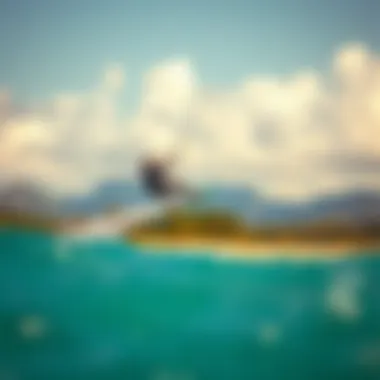
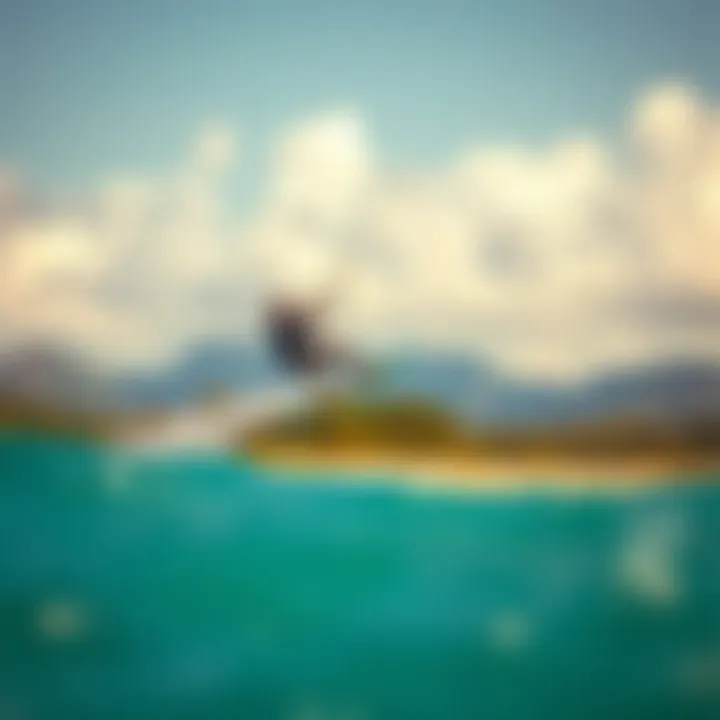
Kiteboarding is more than just a sport; it's a vibrant culture that thrives on a shared love for freedom and adventure. In Mauritius, kiteboarding communities play a vital role in enhancing the experience for both locals and tourists. They create an environment where kiteboarders can connect, learn, and share their adventures, contributing greatly to the island's reputation as a kiteboarding haven.
These communities often act as the glue that holds enthusiasts together, providing support that goes beyond the water. By participating in local clubs and organizations, kiteboarders find opportunities to improve their skills, engage in social activities, and foster friendships with like-minded individuals. In a place where the winds are favorable and the waters blessed, these communities offer pathways to not only navigate the waves but also life-long memories.
Local Clubs and Organizations
The essence of cohesion among kiteboarding aficionados in Mauritius can be traced back to local clubs and organizations. Groups such as the Mauritius Kiteboarding Association (MKA) and various kite schools like Kitesurfing Mauritius serve as hubs for both education and fellowship. These organizations offer a range of programs from beginner courses to advanced training sessions, ensuring that every participant, regardless of skill level, has a place to learn and grow.
Members benefit from shared experiences and knowledge, allowing new riders to salsa into the sport with ease. For instance, MKA frequently hosts workshops that cover essential skills, safety measures, and gear maintenance. Not to forget, membership comes with perks like discounts on gear rentals and access to exclusive spots that aren’t commonly known to outsiders.
With a hefty community backing, these clubs often encourage members to partake in vacations and road trips to explore other kiteboarding destinations together. Besides honing skills, members find themselves taking part in an atmosphere where camaraderie is abundant and where everybody roots for one another.
Events and Competitions
Kiteboarding events and competitions form another cornerstone of kiteboarding communities in Mauritius. Events like the Mauritius Kite Jam and regional competitions draw participants from different corners of the world. Such gatherings not only elevate the sport's visibility but also foster a sense of friendly rivalry and excitement among riders of diverse backgrounds.
These competitions often feature categories catering to various skill levels, from novices to pros. Notable events showcase not only riding skills but also creativity in styles, making them an entertaining spectacle. Moreover, these highlights serve as opportunities to attract global kiteboarding talent, benefiting the local community through increased tourism and engagement.
In addition to the thrill of competition, these events nurture community spirit. They include beach parties, workshops, and informal meet-ups, all tailored to encourage social interactions.
"Events are not merely competitions, they're the heartbeat of our kiteboarding culture."
All in all, the kiteboarding communities in Mauritius act as a beacon for enthusiasts, blending fun and learning in ways that cement relationships and grow the sport. Whether you've got years of experience or are just testing the waters, Mauritius offers an environment where anyone can chase the winds with passion and purpose.
Traveling to Mauritius for Kiteboarding
When planning a kiteboarding adventure, understanding how to get to your destination is as crucial as knowing the sport itself. Traveling to Mauritius for kiteboarding isn’t just about buying a plane ticket or packing your gear; it involves a deeper dive into logistics that can make or break your experience. From navigating entry requirements to ensuring you can movement around the island seamlessly, these essentials cannot be overlooked. This section will guide you through the important aspects of making your kiteboarding trip to Mauritius a success.
Visa and Entry Requirements
Entering Mauritius is usually a straightforward process for most travelers, though specific requirements will depend on your nationality. Citizens of many countries enjoy visa-free entry for stays of up to 90 days, allowing plenty of time to ride those waves. However, it is vital to check if your country falls into this category. Remember, it’s not just the arrival that matters; you might have to show proof of onward travel and sufficient funds for your stay.
Here are key points to consider regarding visa and entry:
- Passport Validity: Ensure your passport is valid for at least six months beyond your planned departure date.
- Accommodation Proof: You might need to provide proof of accommodation upon arrival. Keep email confirmations handy.
- Health Regulations: Depending on the time of year and health advisories, there may be vaccination requirements about diseases such as yellow fever. Always refer to CDC.gov or your local health authority for the latest updates.
If you happen to be traveling with minors, ensure you carry the necessary documentation and forms, as these can mitigate any potential issues with immigration officials.
Transportation Options on the Island
Once you touch down on the milky shores of Mauritius, getting around can be part of the adventure. There’s a myriad of transport options available, accommodating everyone from budget-conscious travelers to those looking to indulge a bit.
- Car Rentals: Renting a car is a popular choice for many kiteboarders. It gives you the freedom to explore the coastline and access various kiteboarding spots at your leisure. Just note, you’ll need to drive on the left side of the road, which may take some getting used to.
- Public Transport: The local bus system is one of the most economical ways to get around. Buses run frequently between major towns, including routes to famous kiteboarding areas.
- Taxis and Ride-Sharing: If you prefer not to drive, taxis are a reliable option. Ride-sharing apps like Uber also provide a convenient means to navigate the island without the fuss of catching local transport.
- Airport Transfers: Many hotels offer transfer services, which can make it incredibly easy to hop from the airport to your accommodation without the hassle of organizing transport upon arrival.
No matter which method you choose, plan ahead. It’s advisable to have a rough itinerary, ensuring that you can maximize your time on the water rather than being stuck in traffic or searching for a ride.
In summary, traveling to Mauritius for kiteboarding entails more than just finding the right kite and board; it’s about anticipating your journey from arrival to transport on the island. By familiarizing yourself with visa requirements and transport options, you’ll put yourself in a prime position to enjoy the breathtaking coastlines and exhilarating winds that await.
"Preparation is key to a smooth adventure; be informed, be equipped, and let the winds guide your adventure."
For further reading, check about Mauritius entry requirements on Wikipedia or plan your transportation via Mauritius Tourism.
Stay tuned as we dive into The Future of Kiteboarding in Mauritius!
The Future of Kiteboarding in Mauritius
Kiteboarding in Mauritius is not just a trend, it's an evolving spectacle. As seasoned riders and curious newcomers flock to its pristine waters, the future of kiteboarding here holds promising potential. This island nation, with its breathtaking beaches and almost year-round ideal wind conditions, presents a canvas for innovations in equipment, techniques, and best practices in sustainability. This section sheds light on the elements that make the future bright for kiteboarding in Mauritius, emphasizing the significance of responsible practices and the latest trends shaping the sport.
Sustainability Initiatives
In a world increasingly aware of environmental concerns, Mauritius is stepping up its efforts to protect the delicate ecosystems surrounding its waters. Kiteboarding, while exhilarating, can have a significant impact if not managed properly. The local community is advocating for sustainable kiteboarding practices that not only enhance the experience but also preserve the natural beauty of the island.
- Eco-friendly equipment: Many brands are beginning to produce kites and boards that are made from sustainable materials. These include biodegradable products or those crafted from recycled plastic.
- Educational programs: Local organizations conduct workshops and sessions aimed at educating riders about minimizing their ecological footprint. Topics often revolve around responsible interaction with marine life and awareness of local wildlife.
- Marine conservation efforts: Initiatives focused on coral preservation, such as reef restoration projects, are gaining traction. By participating in these programs, kiteboarders can give back to the very environments they enjoy.
Moving forward, adopting these sustainable practices will not only protect Mauritius' natural treasures but could also attract an audience that values environmental stewardship. As kiteboarders, getting involved in these initiatives can enhance the community’s reputation and ensure the sport’s longevity.
Emerging Trends in the Sport
The kiteboarding landscape in Mauritius is increasingly dynamic. Emerging trends are indicative of not just the progression of the sport but also the changing preferences of its enthusiasts. Understanding these trends is key for those looking to immerse themselves fully into the kiteboarding culture of Mauritius.
- Technological advancements: Equipment has never been better. Smart kites equipped with GPS and sensors that give real-time data are making waves. Riders can track their performance and refine their techniques with unprecedented precision.
- Expanded community involvement: Local clubs are integrating more diverse programs tailored for beginners, families, and individuals with special needs. By making the sport more inclusive, they are attracting a wider array of participants.
- Competitive scene growth: Competitive kiteboarding events are cropping up more frequently, showcasing local talent while drawing international participants. These events not only increase visibility for the sport but further enrich the local culture and economy.
"Kiteboarding isn’t just a sport anymore; it’s a lifestyle that reflects the culture of its surroundings. In Mauritius, the sport is blossoming and adapting—both in spirit and practice.”
As kiteboarding in Mauritius gathers momentum, embracing sustainability and innovation will be critical. The island’s enchanting environment deserves careful attention, and trends will need to align with the principles of care and respect for nature. Only then can Mauritius maintain its esteemed position as a kiteboarding haven while ensuring future generations can also ride its winds.



